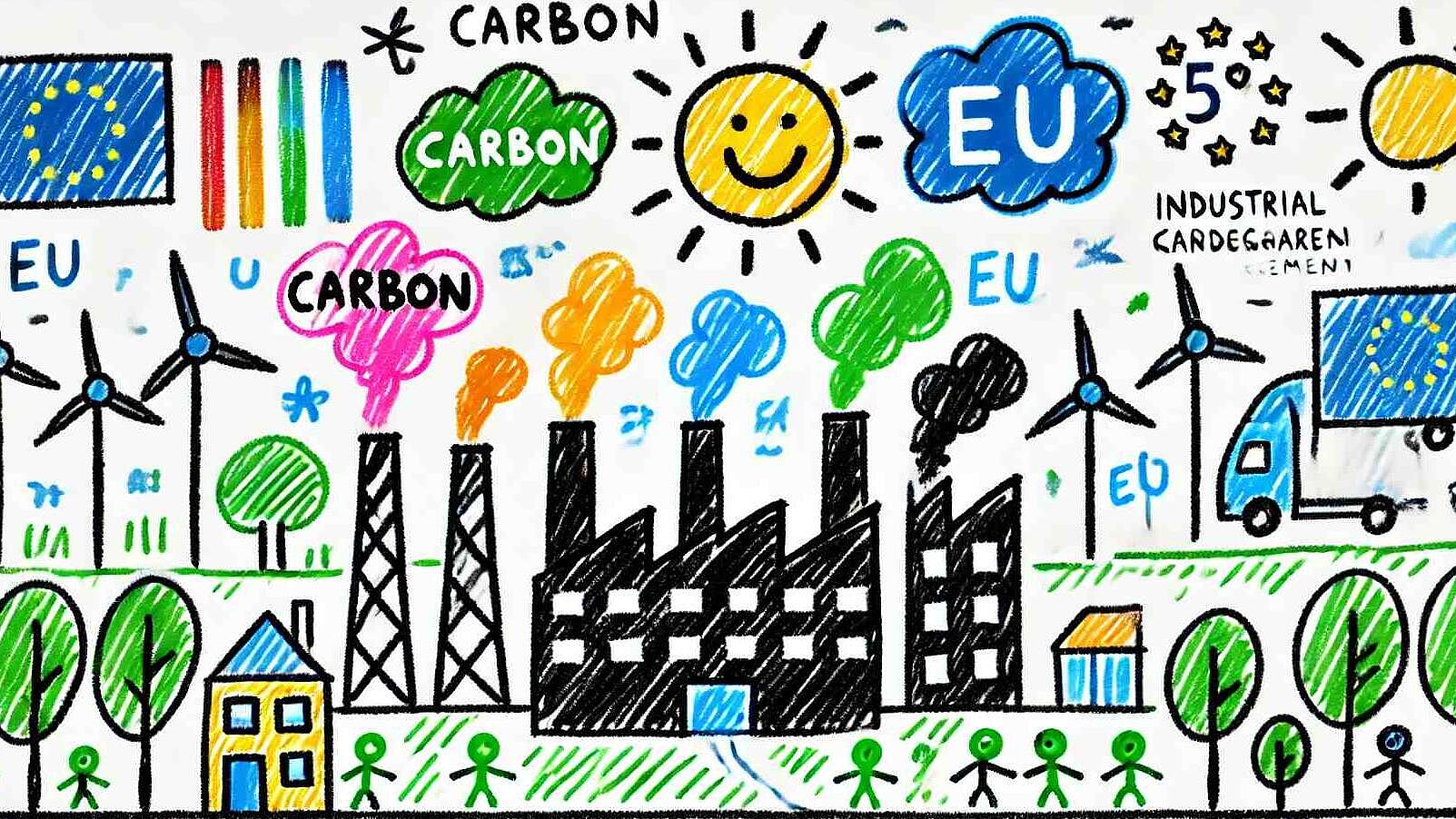 Renewable Energy
Renewable EnergyCasos Prácticos
Harnessing Carbon: Europe's Ambitious Plan for Industrial Carbon Management
Resumen
The EU has unveiled a strategy for industrial carbon management to achieve climate neutrality by 2050, with interim goals of reducing emissions by 55% by 2030. With a focus on carbon capture and storage (CCS), carbon removals, and carbon capture and utilization (CCU), the EU plans to capture roughly 280 million tonnes of CO2 annually by 2040, increasing to around 450 million tonnes by 2050. A significant part of this strategy includes the development of CO2 transport infrastructure, projected to reach 7,300 km by 2030 and expand to 19,000 km by 2040.
Innovative projects like the STORMING initiative are exploring the conversion of CH4 into H2 and carbon nanomaterials utilizing renewable energy. The EU is advocating for enhanced carbon removal technologies such as bioenergy with carbon capture and storage (BECCS) and direct air capture and storage (DACCS) for achieving negative emissions. Economic opportunities arising from this strategy are substantial, with the future CO2 value chain valued between €45 billion and €100 billion, potentially creating 75,000 to 170,000 jobs.
The EU's leadership in industrial carbon management technologies aims to set a global standard and meet Paris Agreement targets, while transforming industrial processes and promoting a circular carbon economy. The EU calls for increased investment, research, public awareness, international cooperation, and a regulatory framework to support the market for CO2 and incentivize carbon removal technologies. Despite challenges, the strategy underscores the EU's commitment to a carbon-neutral future with significant climate and economic benefits.
Abrir artículo completo
Harnessing Carbon: Europe's Ambitious Plan for Industrial Carbon Management
In an era where climate change looms large, the European Union is taking bold steps to reshape its industrial landscape. The EU's strategy for industrial carbon management, as outlined in a recent communication, sets forth a vision that could revolutionize how we think about carbon dioxide (CO2) emissions and their role in our economy.
The Current Landscape
Today, the EU stands at a critical juncture. With a commitment to achieve economy-wide climate neutrality by 2050 and reduce emissions by at least 55% by 2030, the pressure is on to find innovative solutions. Industrial carbon management emerges as a key player in this transformation, offering pathways to decarbonize production processes in vital economic sectors.
The scale of the challenge is immense. By 2040, the EU aims to capture approximately 280 million tonnes of CO2 annually, scaling up to around 450 million tonnes by 2050. This ambitious target requires a multifaceted approach, encompassing carbon capture and storage (CCS), carbon removals, and carbon capture and utilization (CCU).
Innovations and Opportunities
At the heart of the EU's strategy lies a vision for a robust carbon value chain. This includes capturing CO2 from industrial processes, transporting it efficiently, and either storing it permanently or utilizing it as a valuable resource.
One of the most promising innovations in this field is the development of CO2 transport infrastructure. The EU estimates that by 2030, a CO2 transport network spanning up to 7300 km could be deployed, potentially growing to around 19,000 km by 2040. This network, comprising pipelines and shipping routes, would form the backbone of a new carbon economy.
In line with these developments, projects like STORMING are paving the way for breakthrough technologies. This EU initiative is developing innovative structured reactors heated using renewable electricity to convert fossil and renewable CH4 into CO2-free H2 and valuable carbon nanomaterials for battery applications. Such projects demonstrate the potential for synergy between carbon management and renewable energy technologies.
The strategy also emphasizes the importance of carbon removals, particularly through bioenergy with carbon capture and storage (BECCS) and direct air carbon capture and storage (DACCS). These technologies could play a crucial role in achieving negative emissions after 2050, helping to balance out residual emissions from hard-to-abate sectors.
Impact on the Future
The implications of this strategy extend far beyond environmental benefits. By creating a market for captured CO2, the EU is opening up new economic opportunities. The potential economic value of the future CO2 value chain in the EU could range between €45 billion and €100 billion from 2030 onwards, potentially creating between 75,000 and 170,000 jobs.
Moreover, the strategy positions the EU as a global frontrunner in industrial carbon management technologies. This leadership could translate into significant business opportunities on the global stage, as other countries seek to meet their Paris Agreement targets.
The development of a comprehensive carbon management infrastructure also promises to transform industrial processes. For instance, in the chemical industry, captured CO2 could replace fossil-based feedstocks in manufacturing polymers, plastics, solvents, and more. This shift towards a circular carbon economy could significantly reduce the industry's reliance on fossil resources.
Call to Action
The success of this ambitious plan hinges on collaborative efforts across multiple fronts. The EU is calling for:
- Investment and Funding: Recognizing the substantial investment required, the EU is exploring various funding mechanisms. These include the Innovation Fund, the Connecting Europe Facility, and potential new instruments like Carbon Contracts for Difference.
- Research and Innovation: Continued investment in R&D is crucial to drive efficiency, reduce costs, and develop new solutions. The EU has already invested over €540 million in innovative CCUS solutions through its research programs and plans to continue this support.
- Public Awareness: Engaging the public in an informed, transparent debate about industrial carbon management is essential. The EU emphasizes the need for inclusive discussions that address both the opportunities and the concerns surrounding these technologies.
- International Cooperation: The global nature of climate change necessitates international collaboration. The EU is working towards harmonized reporting and accounting of industrial carbon management activities under the UNFCCC framework.
- Regulatory Framework: To create a functioning market for CO2, the EU is developing a comprehensive regulatory framework. This includes addressing issues of CO2 transport, storage permitting, and creating incentives for carbon removal technologies.
Conclusion
The EU's strategy for industrial carbon management represents a paradigm shift in our approach to CO2 emissions. By reimagining CO2 not just as a pollutant but as a valuable resource, the EU is laying the groundwork for a carbon-neutral future that is both environmentally sustainable and economically vibrant.
This strategy is not without its challenges. It requires significant investment, technological advancements, and public support. However, the potential rewards – both for the climate and the economy – are substantial.
As we stand on the brink of this carbon revolution, the EU's vision offers a glimpse into a future where industry and sustainability go hand in hand. It's a future where carbon is managed, not just emitted – a future that could redefine our relationship with one of the most significant challenges of our time.
Source: https://eur-lex.europa.eu/legal-content/EN/TXT/?uri=COM%3A2024%3A62%3AFIN



